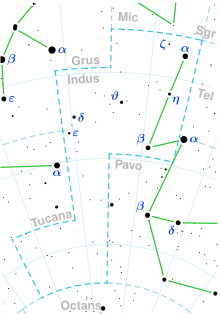Top Qs
Timeline
Chat
Perspective
HIP 107773
Giant star in the constellation Indus with one exoplanet From Wikipedia, the free encyclopedia
Remove ads
HIP 107773 is a star located 344 light years from Earth in the southern constellation Indus.[3] It is classified as a horizontal branch K-type giant star,[3][4] having a spectral type K0III[2] and a radius of 11.6 R☉.[6] With an apparent magnitude of 5.6, the star can be faintly seen with the naked eye.[2] It has an exoplanet, HIP 107773 b, a gas giant orbiting it at a distance of 0.72 astronomical units (108,000,000 km),[7] about the same distance from Venus to the Sun.[a]
Remove ads
Characteristics
HIP 107773 is a giant star, having a spectral type K0III,[2] where K0 means it is a K-type star and III (luminosity class) means it is a giant star. The star is in the horizontal branch phase of evolution.[4][3] HIP 107773 has a radius equivalent to 11.6 solar radii, and a mass equivalent to about 2.4 solar masses.[4] It is cooler than the Sun, having an effective temperature of 4,945 K (4,672 °C).[4][b] Given the mass and the evolutionary stage of the star, its age is estimated to be at least about one billion years.[3]
Remove ads
Planetary system
HIP 107773 has an exoplanet, HIP 107773 b, discovered in 2015 using the radial velocity method.[7][4] The planet is classified as a gas giant, having a minimum mass of 2 MJ[4] and an estimated radius of 1.19 RJ.[7] It orbits its star at a distance of 0.72 astronomical units (108,000,000 km), about the same distance as Venus is from the Sun,[a] and completes one orbit every 144 days (0.39 years).[4] Its orbit is almost circular, with an eccentricity of just 0.09.[4]
With a mass of 2.4 M☉, the star HIP 107773 is one of the most massive stars with a close-in planet.[4][10]
Remove ads
See also
Notes
Notes and references
Wikiwand - on
Seamless Wikipedia browsing. On steroids.
Remove ads

